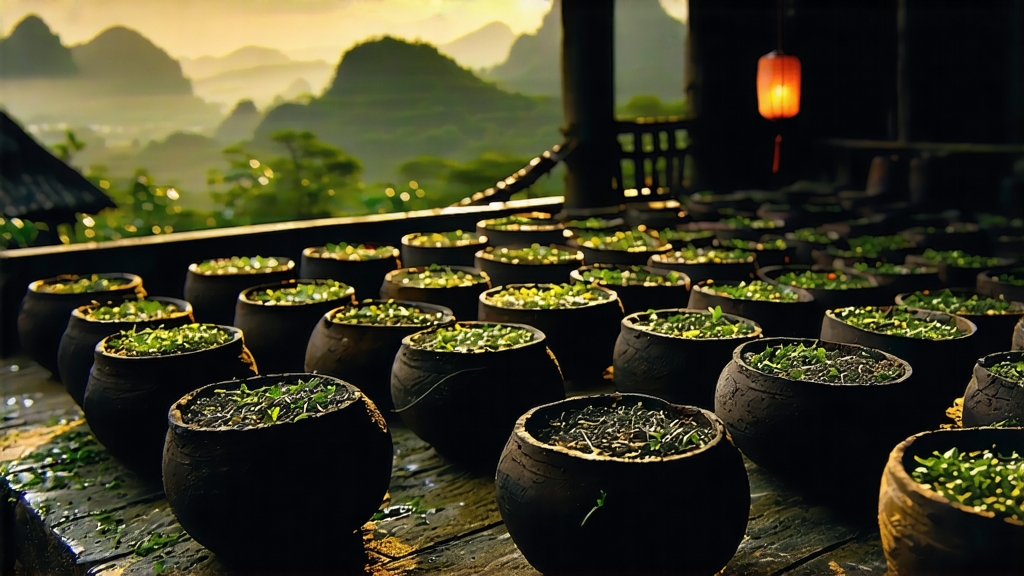
Tucked away in the humid, karst-pocked mountains of southern Guangxi, Liu Bao tea has spent four centuries quietly fermenting while its more famous cousin Pu-erh stole the limelight. Yet inside the clay jars of Wuzhou’s riverside warehouses lies a living relic of the ancient Tea Road that once fed the horse-caravan appetites of Central Asia. Liu Bao is the only dark tea whose name refers not to a processing style but to the exact township where it was first compressed—Liu Bao village, Cangwu County—making it as geographically specific as a single-estate Burgundy.
History: From Border Tribute to Ship Ballast
Ming dynasty tax records from 1585 list “Cangwu dark strips” among the tributes sent northward on the Xun River, but Liu Bao’s global moment arrived two centuries later when the British East India Company needed cheap, dense ballast for clipper ships sailing to Calcutta. Compressed Liu Bao bricks absorbed bilge water without rotting, and dockworkers discovered that the humid voyage actually improved the tea. By 1886 the British tea magnate Jardine Matheson was auctioning “Liu Bao cargo tea” in London alongside Lapsang Souchong, praising its “mellow Chinese oak” flavor. Inland, the Zhuang and Yao minorities used it as barter for salt and iron, pressing it into bamboo tubes and burying it under house foundations so that a child’s birth-year tea could be unearthed at their wedding feast.
Micro-Terroir: Why Guangxi’s Rivers Taste of Betel Nut
The tea gardens sit between the Tropic of Cancer and the 24th parallel, where the Tropic of Cancer monsoon traps fog against limestone cliffs, creating year-round 80–90 % humidity. The soil is a ferric red loam—pH 4.8—laced with decomposed oyster shells from an ancient seabed, giving the leaf a natural coppery sheen. Local cultivars (Camellia sinensis var. sinensis ‘Guangxi Large Leaf’) develop leaves the size of a banana palm, storing extra tannins that later convert into the signature betel-nut aroma.
Craft: The Secret 48-Hour “Wet Pile” That Happens Only in Wuzhou
Unlike Pu-erh’s month-long wo dui, Liu Bao undergoes a shorter, hotter “Guangxi pile.” Fresh leaves are withered 4–6 hours on bamboo racks set above the river so that mist drifts through the leaf. After kill-green in 280 °C woks, the still-soft strips are immediately piled 70 cm deep inside spotless cement chambers. Workers in rubber boots walk the pile every two hours, spraying it with mineral-rich well water kept at exactly 28 °C. A thermophilic microflora dominated by Aspergillus niger and Blastobotrys adeninivorans drives the temperature to 58 °C within 24 hours; the pile is then broken down, re-piled, and finally steamed and pressed into 500 g baskets woven from bamboo shavings. The entire cycle lasts only 48 hours, half the time of Yunnan dark tea, yielding a lighter, more floral fermentation note.
Aging Architecture: Bamboo Baskets vs. Clay Jars
Connoisseurs age Liu Bao in two rival vessels. Bamboo baskets breathe, allowing a slow oxidation that produces camphor and dried longan notes after ten years. Clay jars from Qinzhou—unglazed, 40 cm tall—create a micro-oxygen environment where the tea develops truffle and wet earth aromas. A 1986 basket auctioned in Hong Kong fetched USD 28,000 when tasters detected hints of 1960s Bordeaux cigar box, proving that Liu Bao can rival Pu-erh for investment upside.
Grades & Leaf Code
The industry recognizes five numeric grades based on strip maturity:
- Grade 1: single bud with one unfolded leaf, yielding a golden liquor and orchid nose.
- Grade 3: one bud with two leaves, the sweet spot for daily drinking, balancing betel nut and cocoa.
- Grade 5: three leaves and a sliver of stem, favored by the Zhuang for butter tea.
Anything below grade 5 is called “Guangxi coarse dark” and usually finds its way into Hong Kong-style milk tea cafés.
Brewing: The Gongfu Raft
Because Liu Bao is lightly